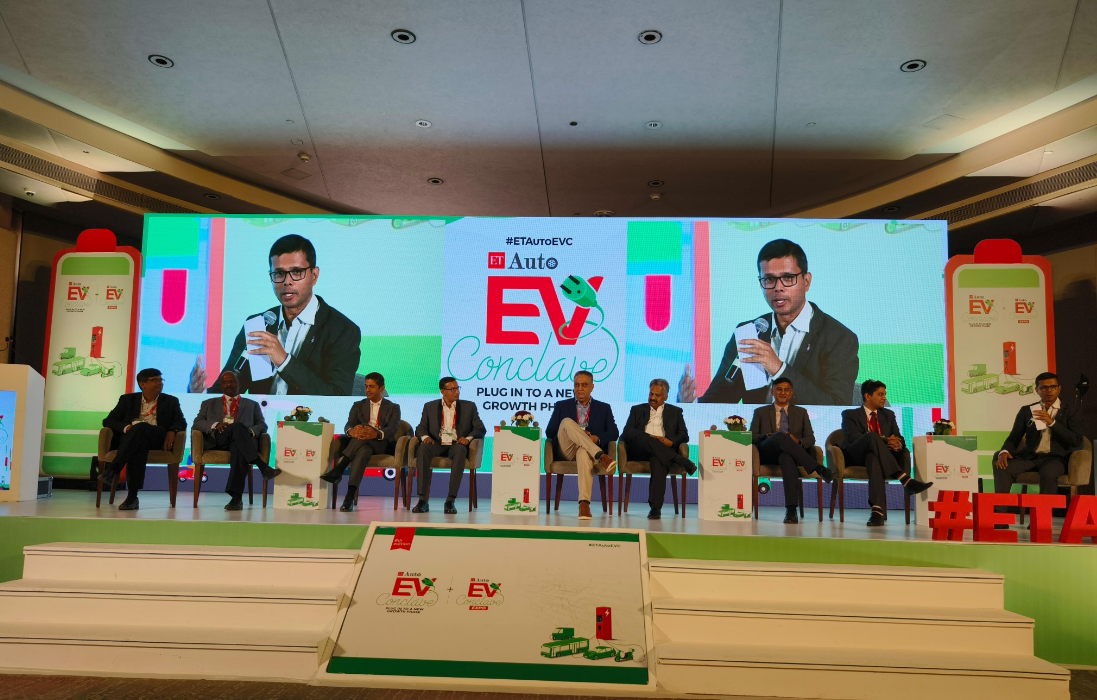
New Delhi: Electrification of mobility is a reality revolutionising the transport industry Global and local necessities are shaping this inevitable revolution. Industry leaders, policy makers and academics converged for the 8th edition of the ETAuto EV Conclave delved into the multi-faceted looming electric revolution.
In an insightful panel discussion on the ‘Design and Development of EVs for Emerging Markets’, they deliberated on the strategies and approaches necessary for the success of this revolution in a dynamic market.
The panel discussion provided a comprehensive overview of the strategies and approaches required for the successful design and development of EVs in emerging markets. From affordability and connectivity to innovative design and technology integration, the insights shared by industry leaders showcased the collective efforts towards shaping the future of electric mobility in India and similar other markets.
The discussion painted a vivid picture of an industry in flux, navigating through challenges and embracing opportunities in the pursuit of sustainable, connected, and personalized mobility solutions. The fusion of technological advancements, engineering prowess, and consumer-centric approaches is propelling the automotive sector into an exciting and transformative future.
Sumantra Bibhuti Barooah, Consulting Editor at ETAuto, moderated the discussion, engaging the panelists in a conversation that delved into the challenges, opportunities, and future outlook for EVs. The panel comprised Tapan Sahoo from Maruti Suzuki India, S J Dhinagar from Ola Electric, Kaushik Ganguly from Clean NRG Technik, S. Ramanathan from Hexall Motors, Parminder Singh from Autodesk, Sridhar Dharmarajan from Hexagon Manufacturing Intelligence India, Srikanth Sudhir from Hinduja Tech. and Lakshmi Narayanan B from CEAT
Tapan Sahoo began by highlighting the global trends influencing the EV landscape, emphasizing five key social changes: global warming, urbanization, an ageing population, digitalization, and a rising propensity to buy vehicles. In the Indian context, he stressed the importance of affordability, connectivity, shared mobility, and environmentally friendly vehicles.
When asked about Maruti’s upcoming EV in 2025, Sahoo refrained from sharing specifics but assured that it would be a competitive vehicle in its segment. Affordability remains a key focus for Maruti, ensuring that their EVs cater to the Indian market’s unique demands.
Sahoo, representing the academic and research perspective, brought the discussion back to the overarching theme of electrification. He illuminated the multifaceted challenges and opportunities that arise in the transition from ICE vehicles to electric vehicles. The use of ultra-high-strength steel, the optimization of battery packs, and the necessity for connected vehicle technologies present a landscape ripe for engineering innovation.
He highlighted the need for a comprehensive approach, encompassing not only powertrain changes but also considerations for energy management, connectivity, and electronic architecture. As he rightly pointed out, the challenges posed by diverse terrains and climates in a country like India demand a meticulous approach to HVAC systems, further emphasizing the interdisciplinary nature of the evolving electric vehicle industry.
Parminder Singh emphasized the need for rapid product development, reduced product life cycles, and lower production costs. Singh stressed the importance of implementing digital technologies for comprehensive design and engineering simulations. He highlighted the shift from traditional simulation methods to realistic simulations in today’s digital age, enabling accurate predictions of a product’s behaviour in a real-world environment.
Parminder Singh shed light on the pivotal role of sustainability in attracting the environmentally conscious Gen X. Beyond product sustainability, organizations are now extending their commitment to sustainability into their manufacturing processes. Singh detailed how Autodesk deploys artificial intelligence to assist customers in experimenting with complete design spaces, fostering sustainable solutions in both product and plant operations.
The narrative took a fascinating turn as Parminder Singh shared a real-world example of Autodesk’s impact on General Motors. In a bid to reduce the weight of seat brackets in cars, GM employed artificial intelligence to generate a manufacturable shape. The result was a three-piece design that not only met manufacturing criteria but also significantly reduced weight. This exemplifies the potential of AI in optimizing product components, a trend likely to proliferate across various industries.
Parminder Singh also introduced the concept of “smartphonification” for cars. He envisioned a future where cars become akin to smartphones, with a decentralized architecture giving way to a centralized one. The younger generation’s changing preferences drive this transformation, where cars are perceived more as gadgets than traditional vehicles. Singh highlighted the importance of making cars user-friendly, enabling easy upgrades and localization of defects.
The fascinating aspect of replicating the signature noise of traditional vehicles into EVs was unveiled, addressing the nostalgia associated with the traditional driving experience. The emphasis on over-the-air upgrades, aligning with the smartphone model, reflects a customer-driven trend demanding continuous improvement without the need for physical visits to service centres.
Kaushik Ganguly offered insights into the challenges of designing EVs for emerging markets. He identified three major challenges: limited control over the EV supply chain, the dominance of ICE markets, and the evolving target customer base during different phases of EV adoption. Ganguly emphasized the need for innovation, suggesting modular manufacturing and exploring battery leasing options to address cost challenges.
S. Ramanathan introduced Hexall Motors’ aim to create a new segment by introducing three-wheelers with six wheels—an unconventional design with twin wheels in the front and dual wheels at the back. This design falls into the L5 category and targets both goods and passenger vehicles. Ramanathan highlighted the focus on last-mile connectivity, offering unique features not seen in existing market offerings.
S J Dhinagar discussed Ola’s journey in the Indian two-wheeler market and the unique challenges and opportunities it presented. He emphasized the importance of creating an electric equivalent to popular two-wheelers, providing advanced features at an affordable price.
Ola Electric focuses on building a connected ecosystem, with software updates and remote troubleshooting capabilities for every vehicle. Dhinagar outlined Ola’s vision of ending the ICE era by offering a range of connected and configurable EVs across various segments.
In the ever-evolving landscape of electric vehicles, Sudhir from Hinduja Tech emphasized the challenges faced by startups and OEMs entering the EV space. Defining a product in this dynamic environment requires addressing fundamental questions about motor types, battery configurations, and other critical elements. This is where engineering service providers play a pivotal role, offering specialized insights and support across the entire product lifecycle.
He touched upon the comprehensive support required for defining, designing, manufacturing, selling, and servicing EVs. Startups, faced with the daunting task of excelling in all these aspects simultaneously, can benefit from the focused competencies and best practices offered by engineering service providers. Sudhir’s insights shed light on how the industry’s transformation isn’t just about developing new technologies but also about providing holistic solutions that enable startups to thrive in a fiercely competitive market.
The conversation then weaved into the domain of tyres, with Lakshmi Narayanan B who delved into the unique challenges posed by electric vehicles in the tyre industry. The lower rolling resistance and increased wear and tear due to higher torque necessitate a reimagining of tire designs. CEAT’s approach goes beyond meeting technical challenges; it involves understanding and meeting consumer expectations in a landscape where driving behavior is undergoing a paradigm shift.
CEAT’s innovative technologies, such as a felt embedded in tyres to dampen vibrations and reduce resonance, reflect their commitment to addressing the specific needs of EVs. The tyre, often overlooked in the grand scheme of automotive innovation, emerges as a critical component in ensuring a smooth and sustainable ride in the era of electric mobility.

